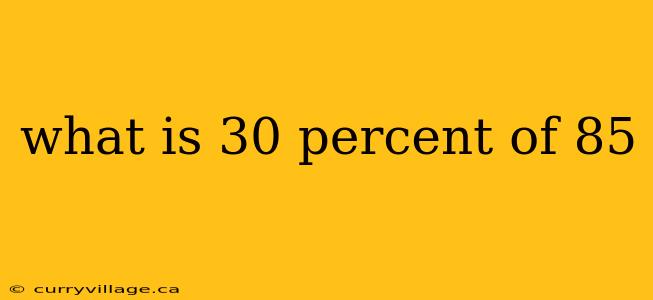Introduction:
Finding a percentage of a number is a common calculation in many areas of life, from calculating discounts to determining tax amounts. This article will clearly explain how to calculate 30 percent of 85, providing a step-by-step approach and alternative methods. Knowing how to calculate percentages is a valuable skill, and this example of finding 30% of 85 illustrates a fundamental mathematical concept.
Understanding Percentages
Before diving into the calculation, let's briefly review what percentages represent. A percentage is a fraction out of 100. For instance, 30% means 30 out of 100, or 30/100, which simplifies to 3/10.
Method 1: Converting the Percentage to a Decimal
This is the most straightforward method.
Step 1: Convert the percentage to a decimal.
To convert 30% to a decimal, divide it by 100:
30% ÷ 100 = 0.30
Step 2: Multiply the decimal by the number.
Now, multiply the decimal (0.30) by 85:
0.30 x 85 = 25.5
Therefore, 30% of 85 is 25.5
Method 2: Using Fractions
This method involves converting the percentage to a fraction and then performing the calculation.
Step 1: Convert the percentage to a fraction.
As mentioned earlier, 30% is equivalent to 30/100. This fraction can be simplified to 3/10.
Step 2: Multiply the fraction by the number.
Multiply the simplified fraction (3/10) by 85:
(3/10) x 85 = 255/10
Step 3: Simplify the fraction (or convert to a decimal).
255/10 simplifies to 25.5
Therefore, 30% of 85 is 25.5
Method 3: Using a Calculator
Most calculators have a percentage function. Simply enter "85 x 30%", and the calculator will directly provide the answer: 25.5. This is a quick and efficient method, especially for more complex percentage calculations.
Real-World Applications
Understanding how to calculate percentages like 30% of 85 is vital in various real-world scenarios:
- Sales and Discounts: Calculating discounts on items during sales.
- Taxes: Determining the amount of sales tax or other taxes on purchases.
- Tips: Calculating tips in restaurants or other service-related industries.
- Financial Calculations: Calculating interest on loans or investments.
- Statistics: Analyzing data and interpreting percentages in reports or surveys.
Conclusion
Calculating 30 percent of 85 results in 25.5. Whether you use the decimal method, the fraction method, or a calculator, the answer remains the same. Mastering percentage calculations is a valuable skill applicable across numerous situations. Remember that understanding the underlying concepts helps in tackling more complex percentage problems.
